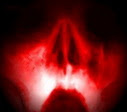Country: Japan
Genre: Sci-Fi / Horror
Running Time: 97 min.
Producer: Hideo Nishimura
Director: Hiroki Yamaguchi
Cast: Luchino Fujisaki, Yoshiichi Kawada, Ryôsuke Koshiba, Kae Minami…
GHOUL RATING:
**(*)
2+
Story: 17-year old schoolgirl Luchino has a smoking problem. In an oppressive, futuristic society where smoking is prohibited, her attempt to violate this rule accidentally sets off a fire and explosion in one of the corridors. Running away, she ends up in an elevator, which is the main means of transport within the crammed megalopolis (which we never see, but so we’re told). Pretty soon she gets trapped there with a group of unusual characters, including two convicted rapists being escorted to their execution. Of course, they are not in chains for long, and then… blood splatters the sickly-greenish walls and floor…
Review: The title HELLEVATOR makes this sound like a cheesy Charles Band production (say, about a killer elevator in a ‘modern’ high-rise; or, a gateway to hell posing as an elevator, or some such); however, the original title BOTTLED FOOLS doesn’t make it sound much better. Under any other name, this rose would still smell low-budget but, luckily, this is not the type of flick the title(s) would make you expect. HELLEVATOR belongs to a subgenre that fat encyclopedias usually define as ‘a bunch of unsympathetic caricatures (or was it ‘characters’?) confined to a single set, yelling at each other for at least 90 minutes’. Being trapped in an elevator is bad enough; but, to be trapped with a gang of hysterically screaming Japanese provides a totally new definition of Hell - so I guess the American title is accurate after all. Add a couple of rapists and a mad scientist to liven up the proceedings, and you get bottled fools too.
The futuristic design and claustrophobic setting led some to compare this effort to a budgetary-challenged Canadian SF-horror CUBE (1998), and to be honest – some similarities are there: one main set, poor acting, lots of screaming, quite a lot achieved from the limited resources, etc. The main difference with CUBE and other members of the ‘confined claustrophobic quarrelling’ subgenre is that there is no immediate threat in the setting, or from outside. Horror comes mostly from inside the elevator. Freud said something like ‘A man is a wolf to another man’: or, to put it simply, it’s people giving hell to one another in this film. And not just the usual suspects (or convicts) either! Torment also comes from inside, since our main character, Luchino, is plagued by the memory of killing her abusive father (talk about Freud!), and – to add insult to injury – her telepathic abilities which enable her to peek into the unsavory minds of her fellow passengers.
HELLEVATOR was directed by Hiroki Yamaguchi, revealed in the additional features on the disc as a likable young man in his mid-twenties. Orson Wells he ain’t, but let’s say he could become a solid Japanese Don Coscarelli. Shot on digital video, with a group of unknowns, using (literally) discarded waste material for the sets, HELLEVATOR does not (and cannot) hide its very low budget origins. Yamaguchi uses all kinds of editing tricks to overcome the limitations of his setting and make the rhythm faster. Decent lighting and framing make the grainy images palatable, although the pea-soup-vomit color of the inside of elevator may become too oppressive after a while. In spite of no budget, Yamaguchi even managed to squeeze in an amazingly accomplished bullet-time sequence, and the ‘Making of’ documentary reveals the unbelievably simple way it was done!
All this is very well, but how much fun is there to be had on this HELLEVATOR ride? Let’s see. Gore is flowing freely: no complex latex effects here, but red spells red. The obligatory rape scene is there, too. What, you thought the Japanese would make a SF-horror without one? Hey, that would be like a good old American slasher from the ’80-ies without a shower scene! Cool gadgets made of scrap? Check! Uber-cool characters? There’s this guy with dark shades and a walkman, sitting in a corner, unmoved through most of the carnage; how’s that for ‘cool’? Heroine, on the other hand, is pretty, but bland (let’s say: pretty bland). All the rest are the kind you cannot wait to see dispatched ASAP. Any subtext for your intellect to chew on? Well, you might read some into it, what with the oppressive society of the future as imagined by a teenage boy who hasn’t read much else than manga, but that’s as far as it gets. The ‘twist’ ending might give you some food for thoughts, provided you freeze-frame it to see what’s there for 15 frames (non-Japanese viewers are advised to watch the interviews on the disc for further explanation. Note: that blink-and-miss image was NOT the Eiffel tower!).
The end result is a watchable, occasionally entertaining, but mostly underdeveloped and uninvolving film. It is a great showcase for its director: we should pray that he gets more money, and more inspiration, for his further films, for he certainly showed a considerable technical talent here. In the future, let’s hope for more substance to his stories, and more budget and style to his direction. Till then, you may want to rent this, but I’m not sure how much it deserves to be owned and re-watched.






Nice blog here! Thank you!
ОдговориИзбриши